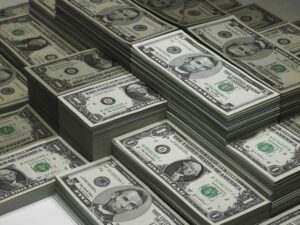
Australian and New Zealand Dollars Hit Multi-Month Highs as China’s Stimulus Boosts Risk Appetite

The Australian dollar (AUD) and New Zealand dollar (NZD) surged to multi-month peaks on Wednesday, driven by China’s aggressive stimulus package, which has fueled investor risk appetite. Meanwhile, the Chinese yuan (CNY) also hit its strongest level in over a year, as markets reacted positively to the latest economic support measures from China.
Impact on the U.S. Dollar (USD)
In contrast, the U.S. dollar, typically seen as a safe-haven currency, came under pressure. China’s significant stimulus efforts, combined with rising expectations of a possible U.S. interest rate cut in November, have weakened the greenback. The Australian dollar peaked at $0.6908 during early Asian trading, marking its highest level since February 2023, while the New Zealand dollar reached a nine-month high of $0.63555.
Australian Dollar Reaction to Domestic Data
Despite early gains, the Australian dollar pared back some of its advances after data showed that domestic consumer prices in Australia slowed to a three-year low in August. Core inflation also dropped to its lowest level since early 2022, bringing the AUD down slightly to $0.6891.
Chinese Stimulus Measures and Global Market Reaction
Global markets rallied following China’s announcement of a robust support package, which included large-scale rate cuts and measures aimed at boosting its stock market. These moves have been particularly favorable for currencies with strong economic ties to China, such as the Australian and New Zealand dollars.
“Market reactions suggest these announcements were larger than expected, which especially benefits currencies like the Aussie and kiwi,” said Carol Kong, currency strategist at Commonwealth Bank of Australia.
New Zealand Dollar Gains and Dairy Exports
The New Zealand dollar outperformed its G10 peers, thanks to expectations that China’s stimulus will bolster consumer demand, a positive indicator for New Zealand’s dairy exports, a key part of its economy.
Yuan Reaches 16-Month High
The Chinese yuan also surged, with the onshore yuan rising to a 16-month high of 7.0012 per dollar. Its offshore counterpart briefly breached the critical psychological level of 7 per dollar, reaching 6.9952.
Currency strategist Christopher Wong of OCBC noted, “The yuan’s momentum will largely depend on the performance of China’s equity markets, which serve as a proxy for overall market sentiment.”
Sterling and Other Currencies
Elsewhere, the British pound (GBP) advanced by 0.1% to $1.3430, a level not seen since March 2022. Support for sterling came from less aggressive rate-cut expectations from the Bank of England compared to the Federal Reserve.
Fed Rate Cut Expectations
The CME FedWatch tool now indicates a 59.5% chance of a 50-basis-point rate cut at the Federal Reserve’s next policy meeting, up from 37% a week earlier. Recent data showed U.S. consumer confidence unexpectedly dropped in September, raising concerns about the labor market’s health.
According to Wells Fargo economists, “Consumers remain cautious about the economy, and the moderating labor market is a key concern.”
Dollar Index Near One-Year Low
The U.S. dollar index, which measures the greenback against a basket of currencies, stood at 100.26, near a one-year low of 100.21. The index had dropped over 0.5% in the previous session, marking its biggest one-day percentage decline in a month.
Euro and Yen Movement
The euro (EUR) edged up by 0.14%, trading at $1.1195, near its 13-month high. Meanwhile, the Japanese yen (JPY) softened slightly to 143.32 per dollar.
Never miss any important news. Subscribe to our newsletter.
Related News


USD/INR Slows Down Amid Mixed Indian PMI Data.


USD/INR Rises as Markets Anticipate Fed Rate Decision.


Gold Price Nears Record High Amid Strong Safe-Haven Demand.



USD/INR Gains Momentum Amid Trade Tariff Uncertainty.



Never miss any important news. Subscribe to our newsletter.
Editor's Pick


USD/INR Slows Down Amid Mixed Indian PMI Data.


USD/INR Rises as Markets Anticipate Fed Rate Decision.



